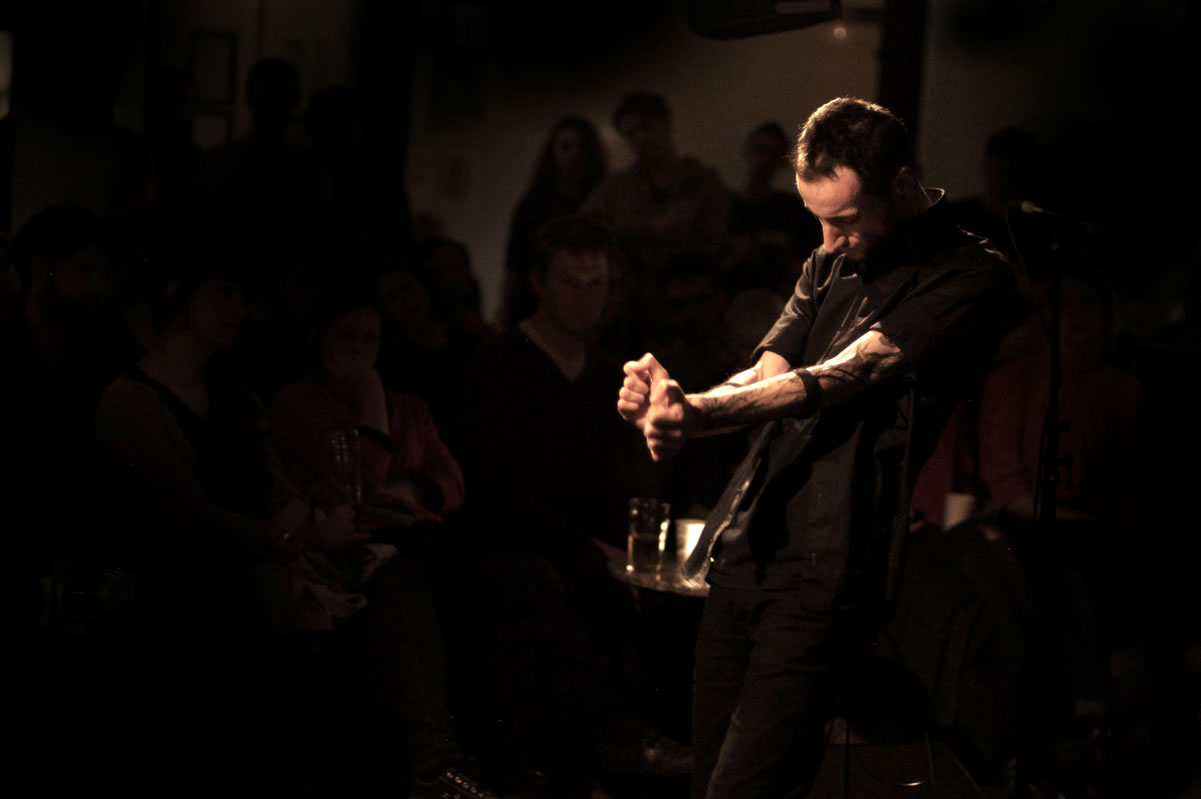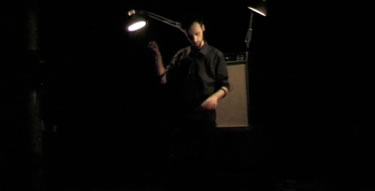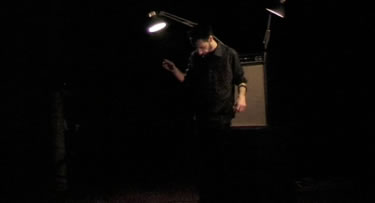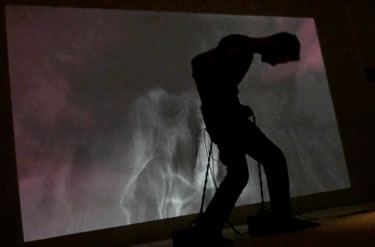[Gallery]
Marco Donnarumma
The works presented here are both based on the Xth Sense, a biophysical, wearable interactive technology for musical performance and responsive milieux. The Xth Sense is an interactive system based on free software and open hardware. The project goal is to investigate exploratory applications of biological sounds, namely muscle sounds, for musical performance and responsive milieux.
In 2012, Xth Sense was named the 2012 “world’s most innovative new musical instrument” by the Georgia Tech Center for Music Technology (US).
For more information on the artist’s performance practice using the Xth Sense and particularly for the piece Hypo Chrysos, see his article “Proprioception, Effort and Strain in Hypo Chrysos: Action art for vexed body and the Xth Sense,” also published in this issue of eContact!
Music for Flesh II (2011)

Music for Flesh II (2011) is a seamless mediation between human biosonic potential and algorithmic composition.
The work defines a temporary cognitive time zone in which the physical space of the performance is augmented, stretched, enlightened, obscured, dominated by a real-time reconstruction of the human body’s primal expressiveness.
Body is no longer silent, and the embodied interaction which was so far kept mute, now acquires a new textural layer, a tangible and profound level of interpretation and representation which can be simultaneously intimately experienced by the performer and audibly and visually externalized in order to embrace the audience.
By enabling a computer to sense and interact with the muscular sonic potential of human tissues, the work approaches the biological body as a means for computational artistry.


I stand in a dark room, lit with two spotlights. When the visitors enter the room, the performance begins. During my performance, muscle movements and blood flow produce subcutaneous mechanical oscillations, which are nothing but low frequency sound waves. Two microphone sensors capture the sonic matter created by my limbs and send it to a computer. This develops an understanding of my kinetic behaviour by listening to the friction of my flesh.


Specific gesture, force levels and patterns are identified in real time by the computer; then, according to this information, it manipulates algorithmically the sound of my flesh and diffuses it through an octophonic system.
The computer learns about and interacts with the performance: for instance, strong and wide movements repeated for longer than 30 seconds prompt the computer to increase the loudness and density of the processed output; a repeated excitement of the left bicep causes a rich vibrato; an abrupt contraction of the right forearm moves the sound across the right side of the sonic field.
The neural and biological signals that drive the performer’s actions become analogous expressive matter, for they emerge as a tangible, haunting soundscape. The border between physical and virtual body is blurred and dissolved; by harvesting pure kinetic energy from corporeal sounds, incarnated gesture and concrete vibrations, the piece actualizes before the audience’s eyes as a visceral and cognitively challenging territory.
Hypo Chrysos — Action art for vexed body and biophysical media (2012)

Hypo Chrysos (2011) is a work that exasperates the viscerality of the body system, so to critically explore the territory in between biosciences, technology and performance art.
This live audiovisual piece is freely inspired by the sixth Bolgia of Dante’s Inferno, located in one of the lowest of the circles of hell. Here the poet encounters the hypocrites walking along wearing gilded cloaks filled with lead; for Dante this was the punishment for the falsity hidden behind their behaviour, a malicious use of reason which is unique to human beings.
Using my arms to pull two ropes tied to concrete blocks, I struggle to walk along the stage. I can only walk in a circle, I cannot give up until the action is completed.
The friction of human muscle tissues, and blood palpitations produce a biophysical signal in the form of acoustic sound waves. The sounds of my muscle, heart and blood, normally inaudible to human ears, are captured and amplified through the Xth Sense wearable sensors (XS). A computer stores and accumulates those sonic pulses, computing an endlessly growing wall of sound that emerges from an octophonic array of loudspeakers. When the sonic vibrations of my inner body become tangible sound, they breach into the outer world, thus reaching and affecting the bodies of the audience. At the same time, the biosignal is used to create a swarm of virtual entities, lights and organic forms diffused by a video projector; a window into the subcutaneous flesh tissues of the vexed body. The raging clusters of sound and light emitted by my body give rise to an impactive and unstable force field of tension.
This work does not make use of computer vision, other motion tracking devices or proprietary hardware. All sonic and video material is generated in real time by the performer’s body using the XS, a free and open technology for musical performance and responsive milieux, developed by the author.


For more information on the piece, see Marco Donnarumma’s article “Proprioception, Effort and Strain in Hypo Chrysos: Action art for vexed body and the Xth Sense,” published in this issue of eContact!
Social top